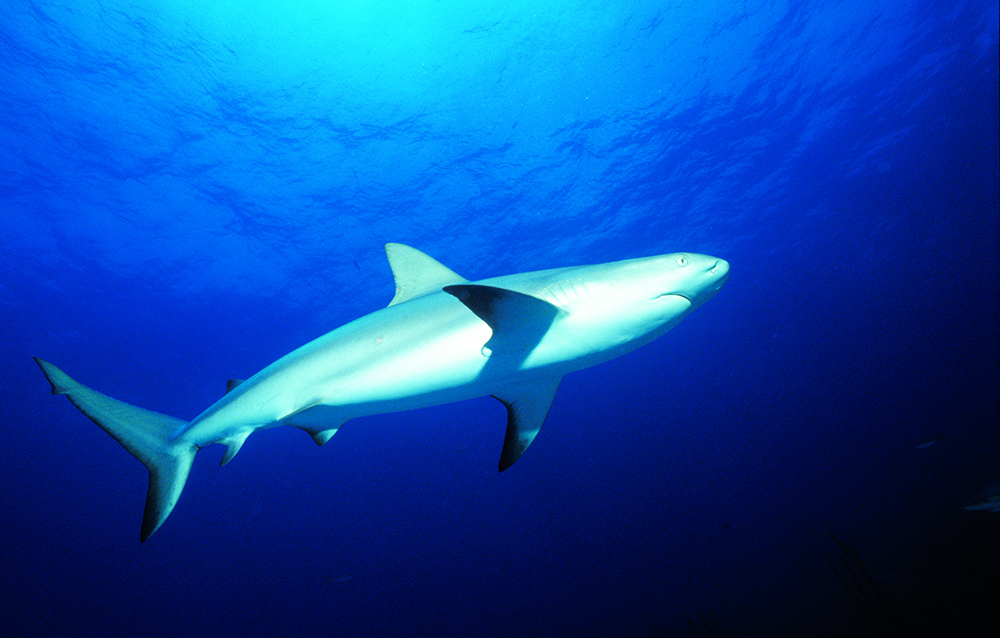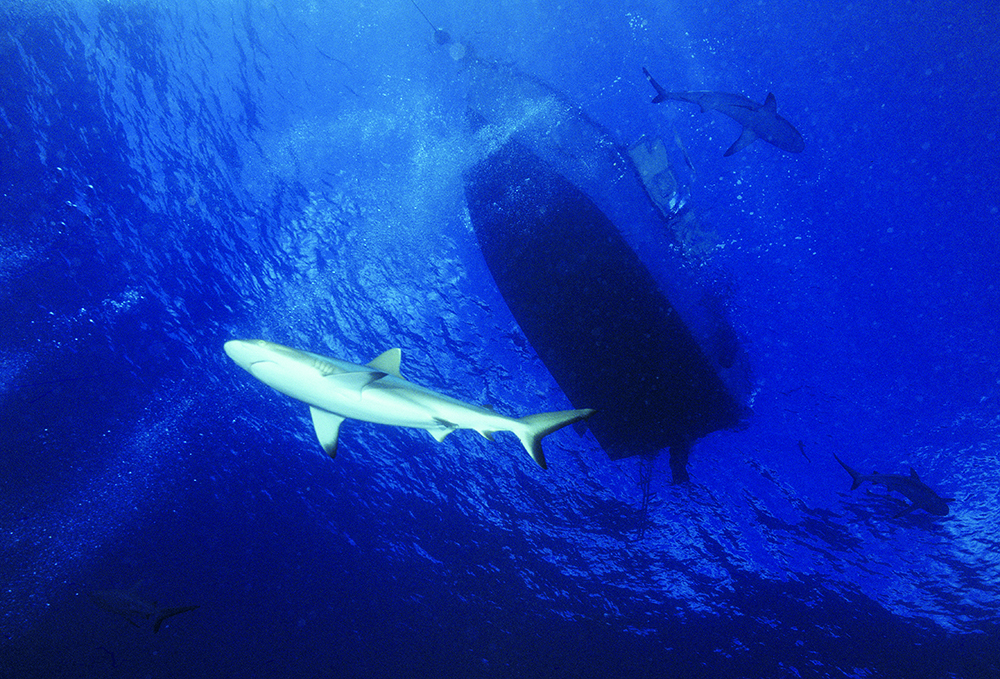Grey Reef Sharks Of The Indo-Pacific
Book Extract
My first visit to the Maldives in the middle of the Indian Ocean saw me visiting the submerged reef known as Mushimashmagili in North Ari Atoll, so named because it’s a gili where great shoals of a local small brown fish called the mushimashma congregate. Nowadays it’s more commonly known among non-Dhivehi speakers as ‘Fish Head’.
Incidentally, the word ‘atoll’ is the only Dhivehi word that has been adopted into the English language. In Dhivehi it means ‘administrative district’ whereas in English it has come to mean a series of islands or reefs in the ocean that surround a body of water known as a lagoon.
Ari Atoll distinguishes itself from the other atolls by having many channels allowing plenty of open-ocean water to flow through its lagoon.
The Maldives were always thought of as having extremely clear water but few who have not visited realise that this water is often subject to extremely fierce currents, especially in the earlier part of the year.
It was unfortunate that we were dropped in by our inexperienced dive guides at the wrong end of the reef. We needed to be at the steep-sided front where the current struck the reef and was directed upwards because it was here that the fish, including the sharks, congregated. I found myself having to drag my body against the flow the whole length of the reef, using my reef hook in the way of an ice-pick. It was a distance approaching a couple of hundred metres and it must have taken me an excruciating fifteen minutes to make it to where I needed to be. When I got to the current-point I was surprised to find that I was the only one of our party to have made it. There I was, alone with the sharks.
I allowed myself to get washed up on to the top of the submerged cliff that forms that end of Mushimashmagili and dug my reef hook deep into a convenient hole in the rocky substrate. I was in this way securely tied off and, provided I didn’t turn my head to one side causing my regulator to free-flow precious breathing air and not let my mask get dislodged, I was able to watch the ongoing show in relative comfort.
The grey reef sharks (Carcharhinus amblyrhynchos) cruised effortlessly up and down, seemingly oblivious to the effects of the torrents of water roaring in from the open atoll, but in actual fact enjoying the oxygenated water that meant they didn’t need to swim to pass it through their gills. There were probably a sufficient number to make double figures but it’s sometimes difficult to count since so many of them are doubles for their kith and kin.

It was at this point that a large octopus decided to take advantage of my otherwise stationary body and climbed out of a hole close beneath me. It was the catalyst for a complete change in atmosphere. In a moment the calm turned to chaos as the sharks went crazy, competing with each other in a sudden explosion of activity in an attempt to be the one to gobble up this delicious prize.
I, for my part, was transfixed. The sharks bumped into me and hurtled around, treating me like a part of the topography. If I was to have been bitten there was precious little I could do to prevent it. The speed of these predators during this brief moment was almost faster than the eye could register. Luckily for me, the octopus realised its serious error and retired quickly and safely back into its hole.
The sharks instantly returned to cruising mode, patrolling up and down where the reef wall obstructed and speeded up the flow of water, ever waiting and ever patient for some other unsuspecting prey to make the mistake of revealing its whereabouts. Tranquillity returned but it gave an indication of how things could change in a moment.
When diving first took off in the Indian Ocean archipelago of the Maldives, a dive centre operator called Hereward Vöitmann used to feed the grey reef sharks in an effort to bring some excitement to the dives he led. His confidence grew and soon he was feeding them by holding the bait in his own mouth. Not only that but I’m told his beautiful young daughter took to feeding the sharks whilst totally naked, and nobody complained about that either – not until he got badly bitten! Shark-feeding by divers has since been banned within the territory of the Maldives.
Anywhere in the tropics that has topography that causes the ocean currents to speed up as they pass over it, rather like the air passing over the wing of a plane, will be a good place for close encounters with grey reef sharks and the otherwise very similar blacktip sharks (Carcharhinas limbatus). In fact, I find the two species so similar that often it’s only once I’ve got back from a dive and had time to study my pictures that I can really determine exactly what species I’ve been looking at.
Blue Corner in Palau is another spot where such sharks congregate when the tide is right and the ocean flows up to the reef wall over the sunken reef top. Like Mushimashmagili in the Maldives, it’s another place famous for reliable grey reef and blacktip shark encounters provided the tide is right and the current flowing.
I went to Bikini Atoll in the remote Marshall Islands to dive the military wrecks sunk as a result of the two atomic bomb detonations from 1946. It was only at the end of the week that we needed to take a day off from diving to off-gas that we went out to the solitary channel that fed the water from the Pacific Ocean in and out of the lagoon with the tides.
We had with us the Bikini islander who had been diving with us. Edward Maddison was built like a boulder. He was as wide as he was tall and appeared to be nothing but muscle. He tossed a few scraps of fish cleanings into the water and it began to boil with the bodies of sharks, mainly grey reef sharks but with a few silvertips dotted amongst them.
Edward would lean over the side of our boat occasionally and grab a conveniently handy small shark by the dorsal fin and tail and, happily grinning, haul it out of the water for us to photograph. I suspect doing this harmed the sharks since they have no bony structure to support their organs but they seemed very happy to swim off quickly after their unscheduled visit to the air-breathing world.

© Not to be reproduced without written permission from Fernhurst Books Limited.
Shark Bytes is written by diving expert John Bantin. John Bantin was an advertising photographer and television commercials director during the '70s and '80s. He learned to dive in 1979 and in 1992 it became his career. He was technical editor for Diver Magazine, Britain's most popular diving magazine. During the past 20 years he has travelled the world gaining many different experiences underwater (not all of them good) which has furnished him with a vast store of anecdotes. He is now known as something of an accomplished raconteur in the diving industry. His first book, the popular Amazing Diving Stories, was published in 2013.